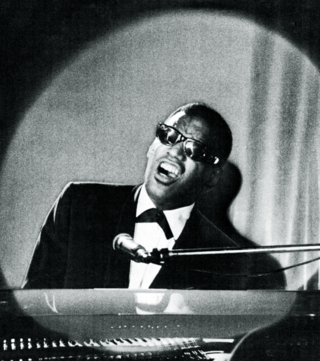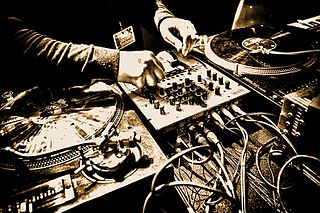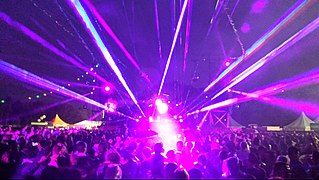
Funk is a music genre that originated in African-American communities in the mid-1960s when musicians created a rhythmic, danceable new form of music through a mixture of various music genres that were popular among African-Americans in the mid-20th century. It deemphasizes melody and chord progressions and focuses on a strong rhythmic groove of a bassline played by an electric bassist and a drum part played by a percussionist, often at slower tempos than other popular music. Funk typically consists of a complex percussive groove with rhythm instruments playing interlocking grooves that create a "hypnotic" and "danceable" feel. It uses the same richly colored extended chords found in bebop jazz, such as minor chords with added sevenths and elevenths, and dominant seventh chords with altered ninths and thirteenths.
House is a genre of electronic dance music characterized by a repetitive four-on-the-floor beat and a typical tempo of 115–130 beats per minute. It was created by DJs and music producers from Chicago's underground club culture that consisted of Black gay men and evolved slowly in the early/mid 1980s as DJs began altering disco songs to give them a more mechanical beat. By early 1988, house became mainstream and supplanted the typical 80s music beat.

Soul music is a popular music genre that originated in African-American communities throughout the United States in the late 1950s and early 1960s. It has its roots in African-American gospel music and rhythm and blues. Soul music became popular for dancing and listening, and U.S. record labels such as Motown, Atlantic and Stax were influential in its proliferation during the civil rights movement. Soul also became popular worldwide, directly influencing rock music and the music of Africa. It had a resurgence in the mid-to late 1990s with the subgenre neo soul, which incorporated modern production elements and hip hop influences.
Microhouse, buftech or sometimes just minimal, is a subgenre of house music strongly influenced by minimalism and 1990s techno.
Tech house is a subgenre of house music that combines stylistic features of techno with house. The term tech house developed as a shorthand record store name for a category of electronic dance music that combined musical aspects of techno, such as "rugged basslines" and "steely beats", with the harmonies and grooves of progressive house. The music originally had a clean and minimal production style that was associated with techno from Detroit and the UK.

Deep house is a subgenre of house music that originated in the 1980s, initially fusing elements of Chicago house with the lush chords of 1980s jazz-funk and touches of soul music. Its origins are attributed to the early recordings of Larry Heard, including his influential track "Can You Feel It".

Liquid funk, liquid drum & bass, liquid DnB, melodic drum & bass, or sometimes just liquid is a subgenre of drum and bass. While it uses similar basslines and bar layouts to other styles, it contains fewer bar-oriented samples and more instrumental layers, harmonies, melodies and ambiance, producing a sentimental atmosphere directed at home listeners as well as nightclub and rave audiences. Music genres such as jazz, soul and sometimes blues have a pivotal influence on liquid funk.
French house is a style of house music devised by French musicians in the 1990s. It is a form of Euro disco and a popular strand of the late 1990s and 2000s European dance music scene. The defining characteristics of the genre are filter and phaser effects both on and alongside samples from late 1970s and early 1980s European disco tracks. Tracks sometimes contained original hooks inspired by these samples, providing thicker harmonic foundations than the genre's forerunners. Most tracks in this style are in 4
4 time and feature steady four-on-the-floor beats in the tempo range of 110–130 beats per minute. Purveyors of French house include Daft Punk, David Guetta, Bob Sinclar, Martin Solveig, Cassius, The Supermen Lovers, Modjo, Justice, Air, and Étienne de Crécy.

Dance music is music composed specifically to facilitate or accompany dancing. It can be either a whole piece or part of a larger musical arrangement. In terms of performance, the major categories are live dance music and recorded dance music. While there exist attestations of the combination of dance and music in ancient history, the earliest Western dance music that we can still reproduce with a degree of certainty are old-fashioned dances. In the Baroque period, the major dance styles were noble court dances. In the classical music era, the minuet was frequently used as a third movement, although in this context it would not accompany any dancing. The waltz also arose later in the classical era. Both remained part of the romantic music period, which also saw the rise of various other nationalistic dance forms like the barcarolle, mazurka, ecossaise, ballade and polonaise.
Drum and bass is an electronic music genre that originated in the UK rave scene having developed from breakbeat hardcore. The genre would go on to become one of the most popular genres of electronic dance music, becoming international and spawning multiple different derivatives and subgenres.
Nu-disco is a 21st-century dance music genre associated with a renewed interest in the late 1970s disco, synthesizer-heavy 1980s European dance music styles, and early 1990s electronic dance music. The genre was popular in the early 2000s, and experienced a mild resurgence in the 2010s.
UK funky is a genre of electronic dance music which originated in England that is heavily influenced by soca, soulful house, tribal house, funky house, UK garage, broken beat and grime. Typically, UK funky blends beats, bass loops and synths with African and Latin percussion in the dembow rhythm with contemporary R&B-style vocals.
Moombahton is an electronic dance music genre, derived from house music and reggaeton, that was created by American DJ and producer Dave Nada in Washington, D.C., in 2009. Nada coined the name as a portmanteau of "Moombah" and reggaeton.
Electro house is a genre of electronic dance music and a subgenre of house music characterized by heavy bass and a tempo around 125–135 beats per minute. The term has been used to describe the music of many DJ Mag Top 100 DJs, including Benny Benassi, Skrillex, Steve Aoki, and Deadmau5.
UK garage, abbreviated as UKG, is a genre of electronic dance music which originated in England in the early to mid-1990s. The genre was most clearly inspired by garage house and jungle production methods, but also incorporates elements from dance-pop and R&B. It is defined by percussive, shuffled rhythms with syncopated hi-hats, cymbals, and snares, and may include either 4/4 house kick patterns or more irregular "2-step" rhythms. Garage tracks also commonly feature 'chopped up' and time-stretched or pitch-shifted vocal samples complementing the underlying rhythmic structure at a tempo usually around 130 BPM.
Amapiano is a subgenre of kwaito and house music that emerged in South Africa in the mid-2010s. It is a hybrid of deep house, gqom, jazz, soul and lounge music characterized by synths and wide, percussive basslines. The word "amapiano" derives from the IsiZulu word for "pianos".





